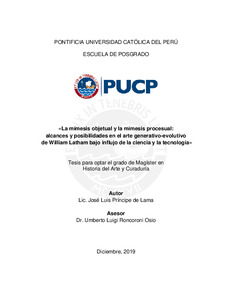| dc.contributor.advisor | Roncoroni Osio, Umberto Luigi | |
| dc.contributor.author | Príncipe de Lama, José Luis | |
| dc.date.accessioned | 2021-01-28T00:11:32Z | |
| dc.date.available | 2021-01-28T00:11:32Z | |
| dc.date.created | 2019 | |
| dc.date.issued | 2021-01-27 | |
| dc.identifier.uri | http://hdl.handle.net/20.500.12404/17970 | |
| dc.description.abstract | El concepto estético de la mímesis ha contribuido a la constante construcción y
enriquecimiento de la narrativa teórica y crítica de la Historia del Arte. La envergadura del
término es tal, que en torno a éste se han justificado los ánimos de independencia de los
referentes, dando paso a los movimientos de vanguardia a inicios del siglo XX. En la
contemporaneidad artística y ante la preponderancia de lo subjetivo como uno de los
valores de la Posmodernidad, parecería que lo que tiene que aportar la mímesis como
recurso validador en la relación artista-mundo se circunscribe al marco de una discusión
caduca. Bajo dicho escenario, los conocimientos y herramientas provenientes de la
ciencia y la tecnología han posibilitado, durante la década de 1980, el arte generativoevolutivo del artista inglés William Latham. El discurso estético de su obra se construye
desde la imitación de procesos naturales, concretamente, de la genética y de la biología
evolutiva, invitando a un repensar de la significación de la mímesis. Ello implica una
revisión del orden semántico–histórico del término hasta su innegable repercusión como
uno de los relatos legitimadores del Arte, incluyendo, necesariamente, las posibilidades de
representación objetiva prevenientes de la inter o la multidisciplinariedad, las mismas que
caracterizan la obra del artista. El corpus de obras de Latham, tomado como caso de
estudio, deja entrever la manifestación de la mímesis en su dimensión procesual,
implicancia que no solo repercutiría en su completitud terminológica, sino también en la
manera de enfrentar y discurrir el Arte mismo | es_ES |
| dc.description.abstract | The aesthetic concept of mimesis has contributed to the constant construction and
enrichment of the theoretical and critical narrative of Art History. The significance of the
term is such that around it the attempts of the models to be independent have been
justified, giving way to the avant-garde movements at the beginning of the 20th century. In
Contemporary Art, and given the preponderance of the subjective as one of the values of
Postmodernism, it would seem that what mimesis has to contribute as a validating
resource in the artist-world relationship is limited to the framework of an outdated
discussion. In this context, knowledge and tools from science and technology have
enabled, during the 1980s, the generative-evolutionary art of the English artist William
Latham. The aesthetic discourse of his work is constructed from the imitation of natural
processes, specifically, of genetics and evolutionary biology, which invites to rethink the
meaning of mimesis. This implies a review of the semantic-historical order of the term until
its undeniable impact as one of the legitimizing narratives of Art, necessarily including the
possibilities of objective representation from inter or multidisciplinarity, which distinguish
the artist's work. Latham's corpus of works, as a case study, shows the manifestation of
mimesis in its procedural dimension, an implication that would not only have an impact on
its terminological completeness, but also on the way of facing and reflect about the Art
itself. | es_ES |
| dc.description.uri | Tesis | es_ES |
| dc.language.iso | spa | es_ES |
| dc.publisher | Pontificia Universidad Católica del Perú | es_ES |
| dc.rights | info:eu-repo/semantics/openAccess | es_ES |
| dc.rights.uri | http://creativecommons.org/licenses/by-nc-nd/2.5/pe/ | * |
| dc.subject | Mímesis en el arte | es_ES |
| dc.subject | Arte y tecnología | es_ES |
| dc.subject | Ciencia y tecnología | es_ES |
| dc.subject | Latham, William | es_ES |
| dc.title | La mímesis objetual y la mímesis procesual: alcances y posibilidades en el arte generativo-evolutivo de William Latham bajo influjo de la ciencia y la tecnología | es_ES |
| dc.type | info:eu-repo/semantics/masterThesis | es_ES |
| thesis.degree.name | Maestro en Historia del Arte y Curaduría | es_ES |
| thesis.degree.level | Maestría | es_ES |
| thesis.degree.grantor | Pontificia Universidad Católica del Perú. Escuela de Posgrado | es_ES |
| thesis.degree.discipline | Historia del Arte y Curaduría | es_ES |
| renati.advisor.cext | 000249672 | |
| renati.advisor.orcid | https://orcid.org/0000-0002-9120-2390 | es_ES |
| renati.author.dni | 40032892 | |
| renati.discipline | 222197 | es_ES |
| renati.juror | Hernandez Calvo, Max Alfredo | |
| renati.juror | Roncoroni Osio, Umberto Luigi | |
| renati.juror | Krebs Pacussich, Victor Jorge | |
| renati.level | https://purl.org/pe-repo/renati/level#maestro | es_ES |
| renati.type | http://purl.org/pe-repo/renati/type#tesis | es_ES |
| dc.publisher.country | PE | es_ES |
| dc.subject.ocde | http://purl.org/pe-repo/ocde/ford#6.04.02 | es_ES |






